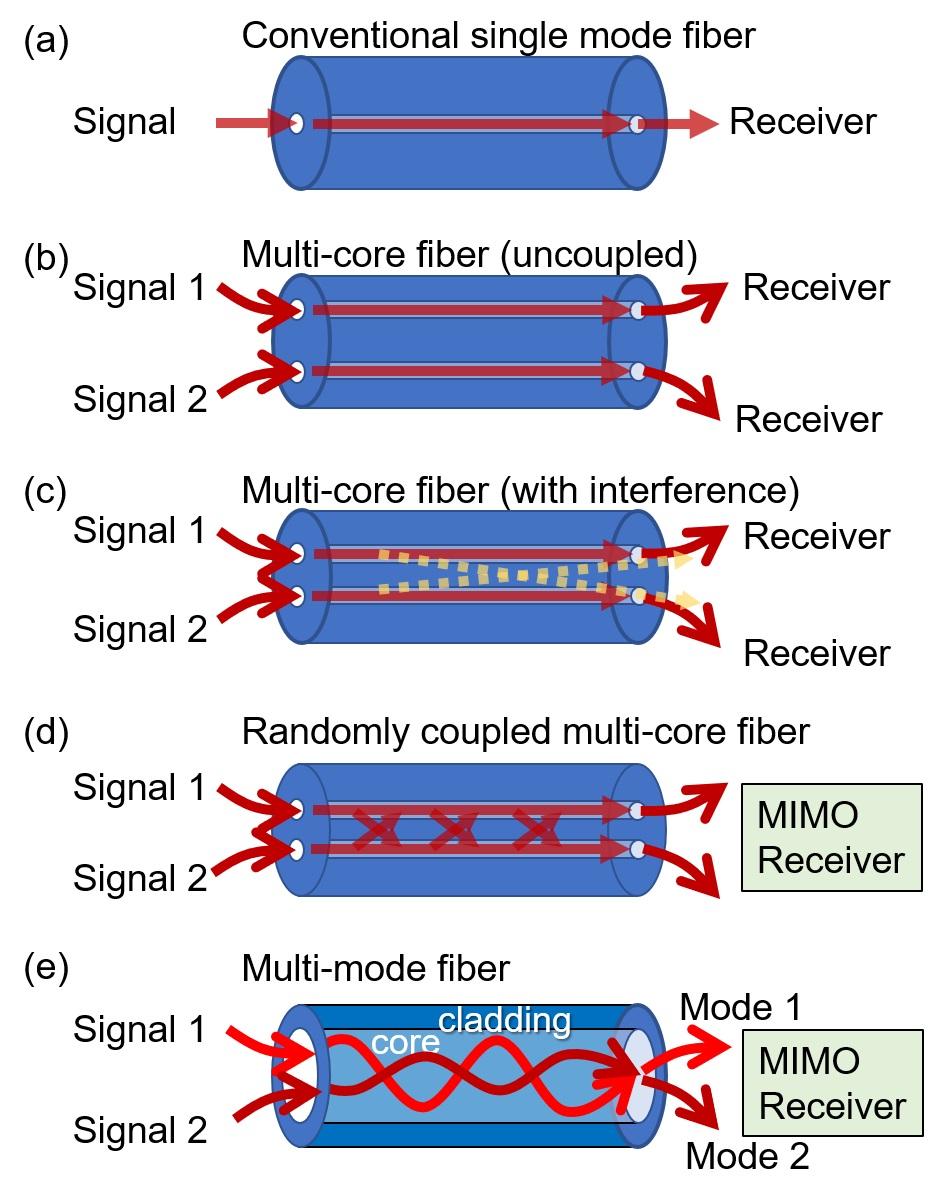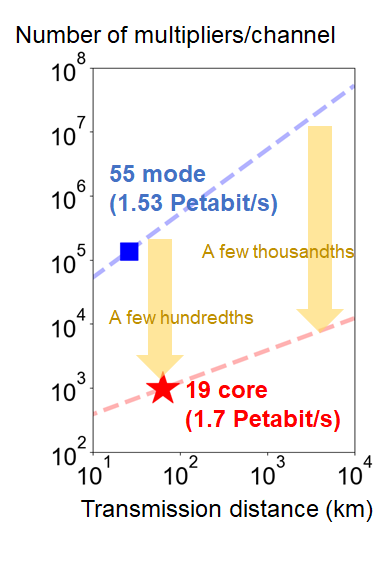10 May 2023
Sumitomo Electric and NICT Develop the World's First 19-core Optical Fiber with Standard Outer Diameter and Set New World Record for Transmission Capacity ーAchieving key technology for beyond 5G long-distance optical communicationー
-
Sumitomo Electric Industries, Ltd.
-
National Institute of Information and Communications Technology
Sumitomo Electric Industries, Ltd. and the National Institute of Information and Communications Technology (NICT) have developed a randomly coupled multi-core optical fiber with 19 cores, the world's largest number of cores for a multi-core optical fiber*1 with a standard outer diameter*2 (0.125 mm), and succeeded in transmitting 1.7 petabits per second over 63.5 km.
【Role】
・Sumitomo Electric: Designed and manufactured of randomly coupled 19-core optical fibers with a standard outer diameter.
To date, Sumitomo Electric has developed a randomly coupled 4-core optical fiber and a randomly coupled 7-core optical fiber with a standard outer diameter suitable for long-distance large-capacity transmission. This time, Sumitomo Electric has realized a randomly coupled multi-core optical fiber with 19 cores, the world's largest number of cores for a standard outer diameter optical fiber, by optimizing the structure and arrangement of cores.
・NICT: Constructed a transmission system to demonstrate the maximum capability of this fiber, and conducted a transmission experiment.
The transmission performance evaluation of randomly coupled multi-core optical fibers is not easy due to signal interference. NICT constructed an optical transmission system that can simultaneously receive 19-core signals at a high symbol rate and evaluated the maximum fiber transmission capacity through wavelength-division-multiplexed coherent transmission experiment.
【Demonstration】
Using commercial wavelength bands (C- and L-bands)*3 and polarization-multiplexed 64 QAM signals,*4 a total transmission capacity of 1.7 petabits per second over a transmission distance of 63.5 km has been demonstrated.
【Demonstration results】
As a result of this demonstration, the companies have not only set a world record for the transmission capacity of standard-outer-diameter multi-core optical fibers, but also a world record for the longest distance in a petabit-per-second class standard-outer-diameter multi-core optical fiber transmission demonstration. These achievements also show the possibility that even if the number of cores in a randomly coupled multi-core optical fiber is increased to 19, the load (power consumption) of the MIMO digital signal processing*5 required for 10,000 km-class transmission for transoceanic communication and other similar applications can be greatly reduced compared to multi-mode optical fiber transmission,*6 demonstrating the scalability of the number of cores in randomly coupled multi-core optical fibers. Randomly coupled multi-core optical fibers and their transmission technology are expected to become a key technology that paves the way for increasing the capacity of long-distance optical communication networks.
The paper on the results of this demonstration was highly evaluated at the 46th International Conference on Optical Fiber Communications (OFC 2023), being selected as the best hot topic paper (Post Deadline Paper) and presented on March 9, 2023.

*1: Multi-core optical fiber
Standard single-core/single-mode optical fiber (see Fig. 1(a)) has a capacity limit of approximately 250 terabits per second. To address this problem, multi-core fibers with increased number of cores (light paths) (see Fig. 1(b)) and multi-mode fibers have been investigated. If the cores of a multi-core fiber are close to each other, the signal in one core leaks into the other cores, causing signal quality degradation due to interference (see Fig. 1(c)). To suppress signal interference, core spacing of an uncoupled multi-core fiber is appropriately increased.
*2: Standard cladding diameter optical fiber
International standards specify that the outer diameter of the glass (cladding) of the optical fiber is 0.125 ± 0.0007 mm, and the outer diameter of the coating layer is 0.235–0.265 mm. The optical fiber widely used in current optical communication systems is a single-core single-mode fiber with a cladding diameter of 0.125 mm, and the transmission capacity is limited to approximately 250 terabits per second.
*3: Wavelength band
The wavelength bands used for telecommunication applications are the C band (wavelength 1,530 to 1,565 nm) and L band (1,565 to 1,625 nm); other bands include the O band (1,260 to 1,360 nm), E band (1,360 to 1,460 nm), S band (1,460 to 1,530 nm), and U band (1,625 to 1,675 nm). In this study, C-band and L-band were used.
*4: 64QAM
Quadrature amplitude modulation (QAM) is a kind of multi-level modulation that uses both the phase and the amplitude of light to represent multiple bits. In 64QAM, each symbol can have 64 different phases and amplitudes in the complex plane and can represent 6-bit information (26 = 64).

*5: MIMO(Multiple Input Multiple Output) digital signal processing
In the transmission using multi-mode fiber or randomly coupled multi-core fiber, MIMO processing for mode/core separation is almost inevitably required at the receiver side. MIMO is a signal processing technology for eliminating multipath interference in wireless communications. In optical communications, it is used to eliminate interference between various optical signals propagating in the same optical fiber.
The load (power consumption) of MIMO processing depends mainly on the number of multipliers and is proportional to the length of the filter function to revert the effects of signal propagation in the fiber. In multi-mode fiber transmission, the length of the filter function depends on the propagation time difference of each mode, which generally increases in proportion to the fiber length. Therefore, the load of signal processing tends to be large in long-distance transmission. In randomly coupled multi-core fiber transmission, the propagation characteristics of each spatial channel (core) are uniform, and the length of the filter function is proportional to the square root of the transmission distance. Transoceanic-class (10,000 km) transmission systems using randomly coupled 19-core fibers will be able to reduce the load of MIMO processing per channel by up to thousands compared to the case of 55-mode fibers (see Fig. 2).
*6: Multi-mode fiber transmission
A multi-mode fiber has a large core diameter, and multiple modes exist within the core (see Fig. 1(e)). Inter-modal signal interference occurs during multi-mode fiber propagation, at the fiber connections, and also at the input/output. Therefore, it is important to eliminate the interference by using MIMO digital signal processing. Multi-mode fiber transmission of 55 modes at maximum was realized.
■ Related item
・ NICT’s press release(May 10, 2023)
https://www.nict.go.jp/en/press/2023/05/10-1.html
・ Sumitomo Electric press release(March 25, 2016)
Sumitomo Electric Has Developed Coupled Multi-Core Optical Fiber Suitable for Ultra-Long-Haul Transmission
https://global-sei.com/company/press/2016/03/prs023.html
